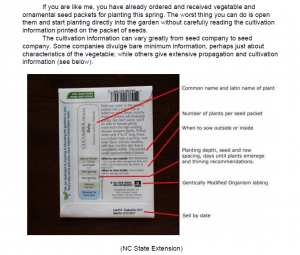By Bob Labozetta —
If you are like me, you have already ordered and received vegetable and ornamental seed packets for planting this spring. The worst thing you can do is open them and start planting directly into the garden without carefully reading the cultivation information printed on the packet of seeds.
The cultivation information can vary greatly from seed company to seed company. Some companies divulge bare minimum information, perhaps just about characteristics of the vegetable, while others give extensive propagation and cultivation information (see below).
Click on image to enlarge.
If you seek more cultivation information than is on the seed packet, refer to the company’s seed catalog and/or website.
The information that a gardener should look for includes:
● An idealized picture of the plant in flower or harvested fruit or vegetable (generally found on the front of the seed packet)
● The name of the variety (technically most are cultivars or cultivated varieties), and whether it is open pollinated, heirloom, or hybrid
● A description of the plant including common and scientific names, plant height at maturity, days to harvest or bloom, and habit (i.e., climbing, upright, etc.)
● For flowers, the type (annuals, biennials, or perennials).
● Suggested uses for the plant such as in containers, in beds, as winter houseplants, for trellises, etc.
● The number or weight of the seeds (useful in determining the number of packets needed)
● The year that the seeds were packaged (Important because as seeds age, their viability decreases, which means that fewer seeds will germinate in subsequent years)
● Germination percentage (tells how many seeds will produce plants under
ideal conditions)
● Planting directions (when to plant the seeds depending on which region in the United States they will be sown, planting depth, spacing, light exposure requirements, whether or not the seeds should be planted indoors prior to planting outdoors, and basic directions for the care of the plant)
● The cold hardiness zone, based on the lowest temperature the plant will survive in.
For more about cultivation information on seed packets, follow this link.
For further gardening information and event announcements, please refer to the Mariposa Master Gardener website Mariposa Master Gardeners or the Facebook page Mariposa Master Gardeners. UC Master Gardeners staff the help desk and phone helpline serving Mariposa County, including Greeley Hill, Coulterville and Lake Don Pedro Phone: 209-966-7078; Email: mgmariposa@ucdavis.edu
Bob Labozetta is a Mariposa Master Gardener




